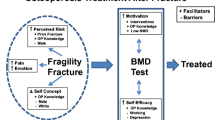Abstract
Treatment of osteoporosis is often inadequate. One reason can be insufficient patient education following diagnostic bone densitometry (DXA). Therefore, we studied how patients are informed and treated following their first DXA. Individuals who had DXA at a rural hospital in Wisconsin were surveyed with a questionnaire regarding their post-test education and prescribed treatment. Their DXA results and the specialty of their clinician were also recorded. Eighty percent of the 1,014 participants were informed of their results. Of the 341 participants who had normal bone mineral density (BMD), 63% reported correct results, while only 31% of the 309 who had osteopenia and 50% of the 364 who had osteoporosis reported correct results. Accuracy in reporting was not affected by the patients’ age or the specialty of their clinicians. Following DXA, 339 patients (33%) were started on medications; 86% of those remained on some prescribed therapy for osteoporosis, but 140 (41%) did not continue the initial medication. Reasons for discontinuation included side effects (48%) and cost (26%). Patients with low BMD who correctly reported their results were more likely to have received a medication and to continue to take it ( p <0.0001). Calcium supplements were recommended to 65% of those not taking calcium prior to DXA. Internists were more likely than family practitioners to recommend calcium, and their patients reported better medication adherence, as did those with osteoporosis compared with osteopenia. We conclude that, while most participants are informed of the results of their DXAs, the retained information may not be accurate. Correct understanding of DXA results may lead to higher treatment rates and better adherence to treatment among patients with low BMD.



Similar content being viewed by others
References
Max W, Sinnot P, Kao C, Sung HY, Rice DP (2002) The burden of osteoporosis in California, 1998. Osteoporos Int 13:493–500
Cooper C (1999) Epidemiology of osteoporosis. Osteoporos Int [Suppl 2]:S2–8
Browner WS, Pressman AR, Nevitt MC, Cummings SR (1996) Mortality following fractures in older women. The study of osteoporotic fractures. Arch Intern Med 156:1521–1525
Siris ES, Miller PD, Barrett-Connor E, Faulkner KG, Wehren LE, Abbott TA et al (2001) Identification and fracture outcomes of undiagnosed low bone mineral density in postmenopausal women: results from the National Osteoporosis Risk Assessment. JAMA 286:2815–2822
Delmas PD (2002) Treatment of postmenopausal osteoporosis. Lancet 359:2018–2026
Harrington JT, Broy SB, Derosa AM, Licata AA, Shewmon DA (2002) Hip fracture patients are not treated for osteoporosis: a call to action. Arthritis Rheum 47:651–654
Follin SL, Black JN, McDermott MT (2003) Lack of diagnosis and treatment of osteoporosis in men and women after hip fracture. Pharmacotherapy 23:190–198
Simonelli C, Killeen K, Mehle S, Swanson L (2002) Barriers to osteoporosis identification and treatment among primary care physicians and orthopedic surgeons. Mayo Clin Proc 77:334–338
Castel H, Bonneh DY, Sherf M, Liel Y (2001) Awareness of osteoporosis and compliance with management guidelines in patients with newly diagnosed low-impact fractures. Osteoporos Int 12:559–564
Kamel HK, Hussain MS, Tariq S, Perry HM, Morley JE (2002) Failure to diagnose and treat osteoporosis in elderly patients hospitalized with hip fracture. Am J Med 109:326–328
Economides PA, Kaklamani VG, Karavas I, Papaioannou GI, Supran S, Mirel RD (2000) Assessment of physician responses to abnormal results of bone densitometry studies. Endocr Pract 6:351–356
Kanis JA (2002) Diagnosis of osteoporosis and assessment of fracture risk. Lancet 359:1929–1936
World Health Organization (1994) Assessment of fracture risk and its application to screening for postmenopausal osteoporosis. Report of WHO Study Group, Geneva, Switzerland
http://www.drl.state.wi.us/, accessed May 2003
Kilding R, Eastell R, Peel N (2002) Do patients receive appropriate information and treatment following bone mineral density measurements? Rheumatology 4:1073–1074
Solomon DH, Levin E, Helfgott SM (2000) Patterns of medication use before and after bone densitometry: factors associated with appropriate treatment. J Rheumatol 27:1496–1500
Fitt NS, Mitchell SL, Cranney A, Gulenchyn K, Huang M, Tugwell P (2001) Influence of bone densitometry results on the treatment of osteoporosis. CMAJ 164:777–781
Pressman A, Forsyth B, Ettinger B, Tosteson A (2001) Initiation of osteoporosis treatment after bone mineral density testing. Osteoporos Int 12:337–342
Tosteson A, Grove, M, Hammond C, Moncur M, Ray G, Hebert G, Pressman A, Ettinger B (2003) Early discontinuation of treatment for osteoporosis. Am J Med 115:209–216
Turbi C, Herrrero-Beaumont G, Acebes JC, Torrijos A, Grana J, Miguelez R, Sacristan J, Marin F (2004) Compliance and satisfaction with raloxifene versus alendronate for the treatment of postmenopausal osteoporosis in clinical practice: An open-label, prospective, nonrandomized, observational study. Clin Ther 26(2):245–256
Papaioannou A, Ioannidis G, Adachi JD, Sebaldt RJ, Ferko N, Puglia M, Brown J, Tenenhouse A, Olszynski WP, Boulos P, Hanley DA, Josse R, Murray TM, Petrie A, Goldsmith CH (2003) Adherence to bisphosphonates and hormone replacement therapy in a tertiary care setting of patients in the CANDOO database. Osteoporos Int 14(10):808–813
Rodriguez-Martinez MA, Garcia-Cohen EC (2002) Role of Ca(2+) and vitamin D in the prevention and treatment of osteoporosis. Pharmacol Ther 93:37–49
Acknowledgement
Special thanks to Susan Nania for research assistance. This research was funded in part by an unrestricted grant from Procter and Gamble
Author information
Authors and Affiliations
Corresponding author
Rights and permissions
About this article
Cite this article
Pickney, C.S., Arnason, J.A. Correlation between patient recall of bone densitometry results and subsequent treatment adherence. Osteoporos Int 16, 1156–1160 (2005). https://doi.org/10.1007/s00198-004-1818-8
Received:
Accepted:
Published:
Issue Date:
DOI: https://doi.org/10.1007/s00198-004-1818-8




